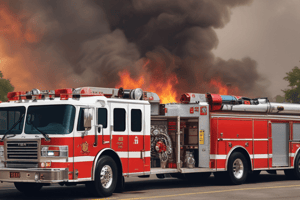Podcast
Questions and Answers
Which of the following is a step in a typical emergency response procedure for a fire?
Which of the following is a step in a typical emergency response procedure for a fire?
- Complete a risk assessment of the situation (correct)
- Turn your back on the fire
- Contact the local fire department
- Evacuate the area without assessing the situation
What type of fire protection system is used in areas where flammable and combustible liquids are processed, stored, or handled?
What type of fire protection system is used in areas where flammable and combustible liquids are processed, stored, or handled?
- Dry chemical fire extinguisher
- Foam-water sprinkler system (correct)
- Water sprinkler system
- Smoke detector system
What is the second-generation dry chemical fire extinguishing agent commonly referred to as?
What is the second-generation dry chemical fire extinguishing agent commonly referred to as?
- Special-K
- Special-Y
- Purple-K (correct)
- Purple-Y
What happens when two metals with different coefficients of thermal expansion are bonded together and then heated?
What happens when two metals with different coefficients of thermal expansion are bonded together and then heated?
What do Class I standpipe systems provide?
What do Class I standpipe systems provide?
Which of the following is a characteristic of foam-making sprinklers?
Which of the following is a characteristic of foam-making sprinklers?
What is the purpose of a rate compensation detector?
What is the purpose of a rate compensation detector?
What is the operating principle of an obscuration smoke detector?
What is the operating principle of an obscuration smoke detector?
Which of the following is the correct hose size for Class I standpipe systems?
Which of the following is the correct hose size for Class I standpipe systems?
Can you control and extinguish a fire using a foam-making sprinkler system?
Can you control and extinguish a fire using a foam-making sprinkler system?
Which of the following is NOT a step in a typical emergency response procedure for a fire?
Which of the following is NOT a step in a typical emergency response procedure for a fire?
What is the purpose of foam-making sprinklers in areas where flammable and combustible liquids are processed, stored, or handled?
What is the purpose of foam-making sprinklers in areas where flammable and combustible liquids are processed, stored, or handled?
What is the dual capability of foam-water sprinkler systems equipped with foam-water nozzles?
What is the dual capability of foam-water sprinkler systems equipped with foam-water nozzles?
What is the operating principle of rate compensation detectors?
What is the operating principle of rate compensation detectors?
What is the purpose of closed-head sprinklers in fire protection systems?
What is the purpose of closed-head sprinklers in fire protection systems?
Study Notes
Emergency Response for Fires
- A typical emergency response procedure includes steps such as alerting occupants, activating alarms, and calling emergency services.
- A characteristic not included in emergency procedures often relates to non-emergency tasks, such as equipment maintenance.
Fire Protection Systems
- Foam-making sprinklers are essential in areas where flammable and combustible liquids are processed, stored, or handled; they suppress fires effectively.
- Second-generation dry chemical fire extinguishing agents are commonly referred to as "multi-purpose dry chemicals."
Thermodynamics of Metals
- When two metals with different coefficients of thermal expansion are bonded together and heated, they can warp or bend due to the differing expansion rates.
Standpipe Systems
- Class I standpipe systems provide a water source for firefighters, specifically for use with 2.5-inch hoses and connections.
- The typical hose size for Class I standpipe systems is 2.5 inches.
Foam-Making Sprinklers
- Foam-making sprinklers control and extinguish fires by applying a blanket of foam that smothers flames and prevents re-ignition.
- Their purpose in environments with flammable liquids is to create a protective barrier over the liquid surface, minimizing vapor release and extinguishing flames immediately.
Detection Systems
- Rate compensation detectors operate by monitoring changes in temperature and adjusting sensitivity in response to rapid temperature increases.
- Obscuration smoke detectors function based on the principle that smoke reduces light transmission; they detect smoke by measuring light obscuration.
Special Features of Fire Protection Systems
- Closed-head sprinklers are designed for specific applications, typically covering areas with sensitive materials, using compacted water patterns to minimize water damage.
- Foam-water sprinkler systems equipped with foam-water nozzles have the dual capability of applying both water and foam, enhancing fire suppression effectiveness.
Studying That Suits You
Use AI to generate personalized quizzes and flashcards to suit your learning preferences.




